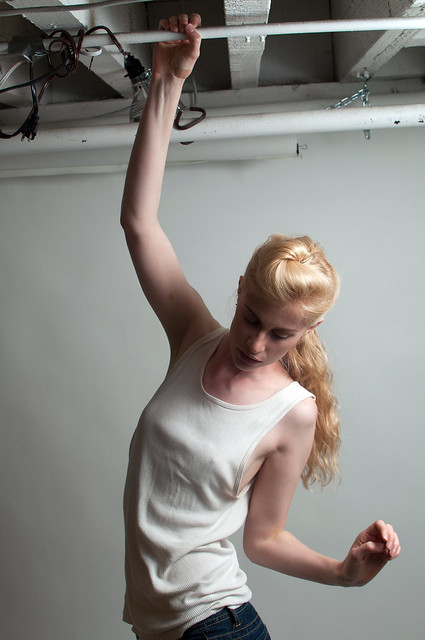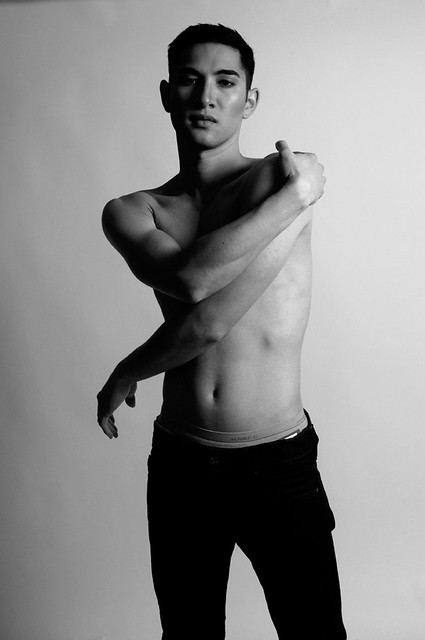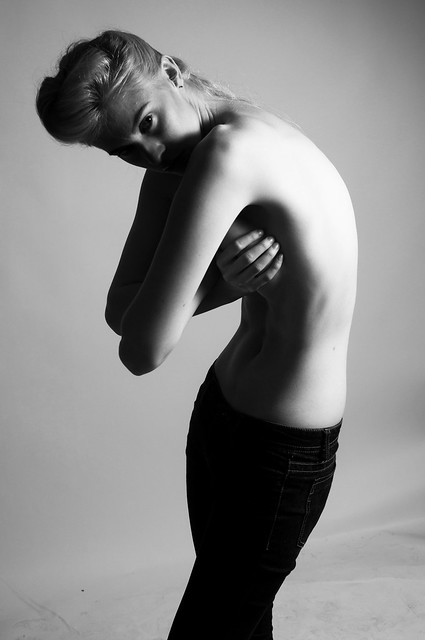By Julio Cortez
Photos by Gregory Moreno
It’s a warm Thursday evening in San Francisco’s Union Square, a bustling shopping destination for those ready to indulge in wool-rich fall essentials during the current Indian summer transition. Bradley Miller, a downtown makeup extraordinaire, gazes at Zara’s fall 2011 womenswear campaign highlighting high-waist men’s trousers and tailored military overcoats. The people at Zara somehow got ahold of the celebrity hairstylist that gave Hollywood’s vanilla starlets that boyishly tussled pixie cut.
Though fashion is constantly evolving, it’s no secret the culture is simultaneously recycling highlights from runways past. The 90’s grunge revival is alive and well, and the return of minimalism echoes on the streets of San Francisco, furthering the androgynous inspired wardrobe of modern day trends. Street style’s latest garbs are geared towards a unisex friendly market, syncing male and female textiles. Color palettes and minimalist basics are now more effortlessly interchangeable among the sexes.
A little navy-blue number is tucked away inside Zara on Sutter Street. Bradley calls earlier in the morning to put the medium, all-over sequin blazer from the women’s fall collection on hold – the largest size in stock in San Francisco. Two others of the same blazer are on the sales floor, both of which are tagged extra-small.
Bradley admits that he would’ve bought the $200 blazer if they had a larger size, pointing his fork at the evening sky above Café de la Presse on Grant Street. The traditional men’s cut with the sparkling twist is what inspires the one time SF State student to plan a disco look around the blazer while he’s at work. “In this city, stores like Zara are always out of large sizes in the women’s department and small sizes in the men’s department.” Could the flocks of slender gender-benders from FIDM be to blame for this? Bradley thinks so.
“I had a very awkward sense of style growing up and boy’s clothes didn’t look good on me,” Bradley says of his thin frame and feminine features.
In middle school, his mixture of boy’s and girl’s clothing even sparks rumors that Bradley is a hermaphrodite. The 1993 beyond baggy jean and over-sized flannel jacket trend have thankfully yet to return to our wardrobe rotation; back then, it was all that was available to boys Bradley’s age.
There’s a misconception about men wearing women’s clothing. Bradley doesn’t want to be a woman, but he gets verbally assaulted for wearing billowy womenswear paired with trim tailored menswear.
“The feeling of wearing clothes is so relevant to how people feel inside,” says Bradley, noting that we all live everyday in fashion. “Why wear something someone else chooses for you to wear?” In Bradley’s world, and for many of the trendsetters in this city, there is no men’s or women’s section – just a giant closet full of inspiration.
“These girls are walking around in their type of fashion – nylon stockings, tank tops as dresses and rainbow colored hair,” says Bradley, praising the Oakland’s street femmes for their ballsy attempt at style. “These girls smell like pot and talk like Lil’ Wayne, but no one is attacking them for dressing the way they dress.”
There’s a cliché that relates to this: fashion is not pretentious, it’s the person wearing the clothes that’s pretentious. Fashion shouldn’t be about menswear or womenswear. It’s the person inside the clothes that’s male or female. “That’s it,” exclaims Bradley.
“I’ve learned to appreciate it for what it is,” Bradley says of getting attacked by downtown haters for his sexually ambiguous attire. “People are seeing in me what they don’t normally see everyday. They’re getting one step closer to accepting it.”
Bradley’s Facebook doppelgangers are McCaulay Culkin and Denise Richards. You’d expect people to freak out a little when they second-guess his looks and not the unisex trousers from American Apparel he wears to work. “I am 100 percent a male in my mind, but people flip their shit because of what I wear.”
Andrej Pejic, the androgynous runway and editorial phenomenon, dubbed male model of 2011 in the fall fashion issue of New York magazine. The issue’s Prettiest Boy In The World feature by Alex Morris highlights Pejic’s ability to make a career of working both sides of the runway.
Lady Gaga ditched her teal wig, archive Gianni Versace silks and fluctuating “Born This Way” era beauty mole at this year’s MTV Video Music Awards. She instead opts for her Jo Calderone alter ego; an Italian, twenty-something, faded lover of Gaga’s with a scorned heart and a vulgar mouth.
The male image is slowly creeping into a state of deconstruction, allowing itself to implement daring details and traditionally feminine influences. Think about where you live and your accessibility to fashion when letting your style freak flag fly. Although gender-bending style is making its way back into the mainstream, it’s easy for some to confuse unisex with cross-dressing and cross-dressing with androgyny.
“What’s androgyny?” asks fashion writer William Biga, a 24-year-old Colorado Springs native and San Francisco transplant. “It doesn’t end or start with dressing like a guy or a girl – it’s more about blurring the lines.”
William believes that it’s easy for the experimental male to throw on a pair of heels, but androgynous style can easily become a gimmick instead of a message. In short, just because you can doesn’t mean you should when it comes to experimenting with gender boundaries.
Something about San Francisco street style allows us the freedom to explore fashion outside of our comfort zones – if we want to. Masculine and feminine come together when utilitarian structure and our generation’s gothic rehash become more readily available at retailers such as H&M, Cotton On and Allsaints Spitalfields.
The San Francisco girl can be identified by her love affair with Dr. Martens, which on occasion is accompanied by a floral dress and fur á la Courtney Love circa Live Through This. The iconic footwear is tied to the punk and skinhead movements, but most importantly its durability as a men’s work boot. Now, more than ever, its widespread accessibility and variation allows it to become a necessary staple for both sexes.
Fashion students trot along Market Street in this season’s knock offs of last season’s runway favorites. Campus gators embrace the combat boot revolution, another unisex trend that has become accessible for boys and girls thanks to budget friendly mall brands.
New wave goth in the 80s got out of control in the hair and makeup department. The style of 90s grunge allowed boyfriends and girlfriends to lend each other their oversized flannels and Nirvana t-shirts in case they want to freshen up their morning walk-of-shame. Today, it’s evident that San Francisco youth love borrowing a note from the good, bad and ugly pages of time.
“You don’t realize how weird San Francisco is and how quickly you assimilate to the city’s ability to liberate you” says William, opting to take his Marlboro smoke break indoors whilst resting on a black weathered coffee table in his barren Nob Hill apartment. “You go somewhere else and people still have a hang up about men using the women’s bathroom. I’m like, ‘really? I’m not in San Francisco anymore.’”
For such a global city, there’s still a sense of everyone needing to adapt to different rules and regulations when it comes to gender and fashion.
Certain parts of the city allow us to express ourselves with clothing a little more freely than others.
“If I wear my skirt downtown, tourists see it as a novelty,” says Biga, “but someone else can reference the inspiration behind my obsession with Rad Hourani.” Hourani is a Canadian designer of Jordanian and Syrian descent recognized for his signature unisex approach to silhouettes.
It’s crucial to comprehend fashion’s regional dialect. Biga recalls one early Saturday morning shortly after moving from Colorado two years ago.
“I was walking down Sutter on my way to work. There was this tall, bearded guy with long black hair pulled up into a tussled Japanese bun,” describes Biga, motioning his hands above his buzzed scalp to mimic the style. “His autumn-colored pleated skirt that went down to his ankles caught my attention, and his tobacco colored boots.”
There was nothing gimmicky about the man’s look, which Biga recalls looking like a Yohji Yamamoto model just a few blocks away from being mistaken as a drug fiend in the Tenderloin. When Biga delivers his skirt look, he admits to just looking “like some gay boy in a skirt.”
For some, their image is based on more than sampling from visual inspiration. Sometimes it’s a little deeper, maybe even a spiritual experience.
By day, Brooklyn bred Terry Tsipouras finds himself managing a doctor’s office in San Francisco. By night, the creative looker performs as a drag queen and promotes local nightlife events. In Greek, his first name is actually Theodoros, which translates to Theodore. He went by Teddy from a young age. When moved to Connecticut, where he was raised, his my mother had such a strong accent and would roll her D’s like R’s that eventually teachers just assumed his name was Terry.
“It’s funny to trace the evolution of your name and how you end up with it,” says Tsipouras, who cites that more often than not you can find meaning in a name’s conception, “in this case I really now understand how I ended up with Terry.”
What’s in a name? “Mine is an androgynous name that really does apply more to me than the latter,” he says, “regardless of not owning it at birth, it still found me through a series of unusual circumstances.” Such is life.
“I have read, in esoteric literature, that an orange energy field covers San Francisco,” says Terry, “this explains why many receive the telepathic calling to come here and pursue some form of personal enlightenment.”
Terry reflects on a calling of his own from the Bay, joining two of his best friends on their move to San Francisco at the same time as Burning Man. At the time, Terry was in an “insecure place of bewilderment,” as he says, having just graduated from the Fashion Institute of Technology in New York with an emphasis on accessories design.
“I had followed all appropriate societal paths towards growth and was still left with an instinctual feeling of incompleteness,” reflects Terry, yearning to discover who he is in the past, present and future.
Following his gut and listening to his heart, Terry realizes that his quest is far from over and that he needs to break his ties in New York City to continue on the path towards self-discovery.
“I called my mother, had her move all of my things to her basement, and started a new life,” Terry admits proudly. “It’s been five and a half years and my journey continues.”
First exposed to the city through Burning Man, Terry describes his experience with San Francisco fashion as spiritually-based futuristic tribal. “I really think that the fashion here is beyond trends,” says Terry. “Exemplifying the theory that fashion starts on the streets with the youth.” That’s not to say that many in the quiet San Francisco scene don’t pay attention to trends, but instead choosing to ignore the trends that other cities around the world are creating.
The experience one has with fashion is personal, which Terry believes is someone’s individual quest calling on them to mirror how they feel on the inside with their clothing. Everything in this city is a statement. “What do I want to tell the world today? How will my exterior armor portray the path that I have endured? What does my image say to the world and does it match my personal journey?” These are questions that Terry believes many San Franciscans, including himself, face when getting dressed.
However, when it comes to the evolution of androgyny, Terry feels it cannot be contemplated through the constraints of something societal and physical such as a city’s border. In fact, he definitely doesn’t see it as a trend, accepting it as something bigger than a person’s lifestyle. “I consider myself to be a Berdache,” says Terry, “a two-spirit being.” Berdache is recognized in the Native American culture, as well as in the cultures of other indigenous tribes. The presence of male and female energies are in him. Although some scientists may argue Terry’s claim through an imbalance of hormones, he doesn’t agree.
“For me,” Terry says, “the ability to channel both male and female energies is a gift from the universe and provides evidence that there is a world beyond the physical.”
San Francisco has a more compassionate and conscious understanding of sexuality that Terry says allows him to dress as he feels without worrying if the garment happens to be made for a woman or a man.
“After all, these restrictions in fashion are all evolved human regulations that mirror current societal standings and their only constant is change,” says Terry.
If you took a stroll through the Castro last December, you may have seen Terry channeling a Greek Jesus on posters for club promoter Joshua J’s “Big Top: Homo for the Holidays.” The poster suggest that Terry prefers to wear Jesus’ birthday suit while two angels hold a banner with the event date over his goodies. If your eyes don’t know where to go when stumbling upon the ad on his Facebook profile, check out the romanticised crucifix tattoo centered on his chest or the flowing brown locks held down by a leather crown of thorns. In an alternate poster, Terry delivers what his friends label a humorous Mary Dragdalene look. We’ll take one of each print if your archives are open, J.
It’s not just religious iconography that inspires the 30-year-old artist. In August, he collaborates with friends, including Bradley Miller, on a photo illustration honoring femininity and its resurgence of power in modern society.
“The message was to tell the world that we are all Gods and Goddesses, that we are all Kings and Queens, that we are all part of the thread of the universe that binds us,” Terry says of the shoot.
In other words, we are all connected. Terry believes that our journey is one of remembrance and back tracking to a place of acceptance and honor, “a place where we were not separate but equal,” emphasizing a loss of unity in humanity overtime. Gender boundaries are broken and blended in the fruition of Terry’s vision, portraying a female as a male, a queen as a commoner, and Egyptian/African as a Caucasian.
“I was seemingly passable to the untrained eye,” admits Terry, “through the use of symbolism, color and posture that we have attached to what we know of as royalty.”
What we see in and out of our own little San Francisco world is completely subjective. “Once all of these labels are stripped away, there lies a being that is just like you, a being conceived and manifested through the wonder that is love,” Terry reminds us.






giuseppe zanotti uk • Jun 4, 2016 at 5:16 am
If all of your hiking book is waterproof, yet you don’t have a gusseted tongue, your hiking boot is not
truly “waterproof” at all. If one of your will get injured it enables the bacteria to get in. This type of professional occupation is
highly in demand in (1) New York City, NY, (2) San Francisco, CA (3) Los Angeles, CA, (4) Columbus, OH, and Chicago,
IL.